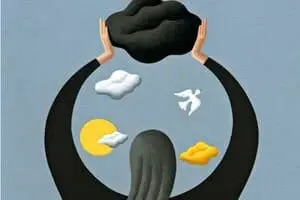As we waited in line at our favorite diner, my sister-in-law, Carol, asked what I thought—no, really thought—of her new outfit. Typically a subdued dresser, today she’d shown up in shimmering purples: a violet T-shirt, plum-colored jeans, and lavender plaid sneakers, which she modeled by kicking one foot high in the air. “You fashionista!” I crowed, and we giggled together, as though this were just an ordinary lunch on an ordinary day.
But it wasn’t. Three days earlier, I’d gathered with Carol and several other family members around an oncologist’s desk. The doctor had gotten right to the point: “The tumor has come back,” he’d said. For the past nine months, Carol had been battling Stage 3 ovarian cancer with a gritty, optimistic spirit. She’d just finished a round of intensive and debilitating chemo, and we’d all hoped for a decent reprieve.
Carol’s face had turned chalky. “How much time do I have left?” she’d asked the doctor. She’d looked at him steadily, her spine as straight as a ballerina’s. He’d ducked his head, scanning his notes. “Six to twelve months,” he’d finally said.
On the drive back home, we were mostly silent, squeezing hands and staring ahead. Carol, a Buddhist of 30-some years, appeared calm, though I knew better than to assume that. Her sister, Sally, and her brother, Dan, who’s my husband, looked spent and numb. I peered out the car window at the impassive Philadelphia skyline and my mind shriveled to a single thought: No.
Now, as we slid into our favorite lunch booth, I noticed that Carol’s hair—once a mass of thick brown curls—was short and silvery, exposing the sculptural shape of her face and head. I thought of painted female profiles on Egyptian vases, swan-necked and vulnerable. The woman sitting across from me had been my friend, as well as my sister-in-law, for more than two decades. Fear thickened in my throat.
But Carol’s mood seemed light, playful even, so I tried to follow her lead. We chatted cheerfully about this and that—Catherine Keener’s latest movie, the scarlet tanager she’d spotted in a nearby park. The waitress arrived with our crab cakes and poured us drink refills. When she left, Carol’s face suddenly caved. “I’m really sad,” she said.
Just the day before, she told me, she’d been perusing the recipe section in the Times and had spied a delectable recipe for Turkish dumplings involving lamb, fresh mint, orecchiette pasta, and a dozen other ingredients. With the verve of a true foodie, she’d reached forward to rip out the recipe—and stopped. Then she froze. “I realized that I don’t have the energy anymore to make a feast like that—and that I never will again,” she said. “My hand just kind of hung there in the air.” Her voice was thin, stunned.
I felt breathless. All of the usual conversational offerings—chummy jokes, attentiveness to this one’s adventure or that one’s insight—deserted us. Death had joined us at the table. After a long minute, Carol leaned forward, her fingers brushing my arm. Very softly, she said, “I’m OK.”
OK? OK? The commonplace word sounded foreign, even bizarre. Trying to keep the tremor out of my voice, I asked, “Carol, how can you be . . . OK?”
She didn’t respond immediately. “I’m sad a lot,” she finally said, and swept her hand toward the window where a nearby Japanese maple stretched its spiky arms to the sky. “All this,” she said, her voice cracking.
Then, after a moment she lifted her arms above her head, making a haphazard hoop in the air. “It’s like this,” she said. On good days, she imagined her life as a kind of circle, a necklace strung with a motley assortment of stones. “When I look at one part of the circle, I see that I’m dying.” She took a shaky breath. “But if I look somewhere else, I see all the people who love me—way more than I ever knew before.” She paused again, composing herself. “Then, over here”—she cocked her head toward yet another spot on her improvised necklace—”I’m perfectly capable of going on an amazing clothes spree!” Carol waved her hand over her new purple ensemble and laughed, her signature trill rippling through the air.
“It’s all there,” she said, more quietly now. “I just try to choose where to look.”
I gazed into my friend’s face and saw that this circle was as alive to her as the scarlet barberry bush that flamed in her garden. I thought of other circles: a juggler’s whirling halo of balls, a fire-dancer’s blazing hoop, the ring of chairs at an AA meeting. I thought of what circle-keepers try to do: hold the shape with grace, swing with it, engage it with respect. But the image made me shiver.
I thought of my own unsteady attempts to roll with the random sucker punches of life. I struggled with a long-term, painful health problem of my own, though vastly less ravaging and final than Carol’s. Thus far, I’d dealt with it by alternately railing against it and attempting to surrender to it, all the while trying to muster sufficient hope to attempt yet one more semipromising treatment. Thus far, this jerry-built protocol had allowed me to muddle through.
But as Carol looked at me across the table, gentle-eyed and gaunt, I saw that my current stratagems would never see me along that other, harrowing path that I was trudging; the one that was leading me, inexorably, out of this life. If I wasn’t doing so hot with a mere illness, how would I handle the slouching approach of death itself?
Honestly, I didn’t know. I made a mental note: Talk more about this with Carol.
But within a week, she’d become too sick to leave home. A hospital bed was carted in. Hospice arrived. Each afternoon at four, her Buddhist sangha arrived to chant and pray in a semicircle around her. Conversations shrank to simple exchanges, and then a few words. Once, while sitting on Carol’s bed and smoothing her hair, I said, “With you, I’ve been able to be myself.” A smile lit her face, briefly. Nine weeks after our lunch date, she was dead.
Seven seasons have turned since then, and the hole in my heart is still ragged. But once in a while, unbidden, I flash on an image of Carol, just three days after receiving the most harrowing news of her life, punching her foot high in the air and showing off her new plaid sneakers. I’m still not sure how she managed that—how, smack in the midst of breathtaking loss, she’d grabbed onto that sweet spot on her circle, like some high-wire acrobat of the spirit. How she’d hung there for a long moment, swung over to grief, and then back to laughter once again, all in the space of a crab-cake lunch.
Even if there’d been time to ask, I’m guessing that Carol wouldn’t have been able to explain quite how she mastered these moves, strenuous and brimming with grace. But she showed me this: I’d better start practicing.
Illustration © Adam Niklewicz
Marian Sandmaier
Marian Sandmaier is the author of two nonfiction books, Original Kin: The Search for Connection Among Adult Sisters and Brothers (Dutton-Penguin) and The Invisible Alcoholics: Women and Alcohol Abuse in America (McGraw-Hill). She is Features Editor at Psychotherapy Networker and has written for the New York Times Book Review, the Washington Post, and other publications. Sandmaier has discussed her work on the Oprah Winfrey Show, the Today Show, and NPR’s “All Things Considered” and “Fresh Air.” On several occasions, she has received recognition from the American Society of Journalists and Authors for magazine articles on psychology and behavior. Most recently, she won the ASJA first-person essay award for her article “Hanging Out with Dick Van Dyke” on her inconvenient attack of shyness while interviewing. You can learn more about her work at www.mariansandmaier.net.













